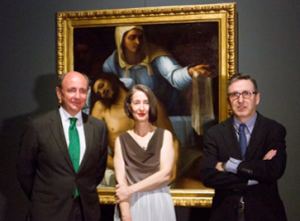“IN LAPIDE DEPICTUM. Italian painting on stone, 1530-1555 “brings together a selection of nine works made on monochrome stone – slate and white marble – by Italian authors such as Sebastiano del Piombo, Tiziano, Daniele da Volterra and Leandro Bassano, which reflect the consolidation of a current of change in artistic techniques that occurred in the first decades of the sixteenth century. Along with them, works of the Roman classic world and rough stone materials contextualize the relationship of painting with Natural History, Geology and Archeology.

Italian authors such as Sebastiano del Piombo, Tiziano, Daniele da Volterra and Leandro Bassano, which reflect the consolidation of a current of change in artistic techniques that occurred in the first decades of the sixteenth century.
Three of the works of the Prado selected for this exhibition have been submitted to a delicate and deep restoration in which the Iberdrola España Foundation participates as Protector member of the Restoration Program of the Prado Museum.
The Museo del Prado presents for the first time an exhibition – curated by Ana González Mozo, Superior Technician of Museums of the Restoration Area of the Prado Museum – dedicated to Italian painting made on stone to show the public the results of the studies carried out on these works, focusing on issues so far little known. A selection of the chosen Prado collection, together with two works from Naples, reflects the consolidation of a current of change in artistic techniques that occurred in the first decades of the sixteenth century. They also exemplify aesthetic and philosophical concepts in force at that time: the reproduction of new pictorial effects controlling the incidence of light on the surface of the painting, the perception of the natural environment encoded in the classical texts, the paragone with the sculpture and the desire to make eternal creations.
Although there are some previous experiences of a general nature in this type of samples, the Museo del Prado has wanted to deepen this phenomenon. On the one hand, studying the theories that stimulated its development and, on the other, exploring the origin of the technique, its relationship with the classical world and the pictorial procedures that Sebastiano del Piombo, Titian and Daniele da Volterra put together to achieve chromatic results different, at the same time that, using non traditional supports, the works arrived until our days in good state of conservation.
The nature of the support and the close relationship established with the polychrome stone of classical tradition during the study has fostered collaboration with other disciplines such as Natural History, Geology and Archeology. A collaboration that has allowed to deepen the practice and the knowledge of the works and that is reflected in the exhibition in several aspects. On the one hand, with the presence of pieces belonging to these areas: works of the Roman classical world and rough stone materials, which help to contextualize the selected paintings and, on the other hand, in a series of very specific studies, carried out with means specific to the aforementioned disciplines, whose results will be published in a publication associated with the sample.
The two works of Tiziano and the workshop of the Bassano, preserved in the Prado, have been subjected to a delicate and profound process of restoration in which, thanks to the sponsorship of the Fundación Iberdrola Spain, different specialties have participated in this discipline (painting, frames and support) so that the visitor can appreciate in its fullness the uniqueness of these works made in oil on supports so special and rare to find in the history of art.
“IN LAPIDE DEPICTUM. Italian painting on stone, 1530-1555 “, which can be visited until August 5 in room D of the Jerónimos building.
